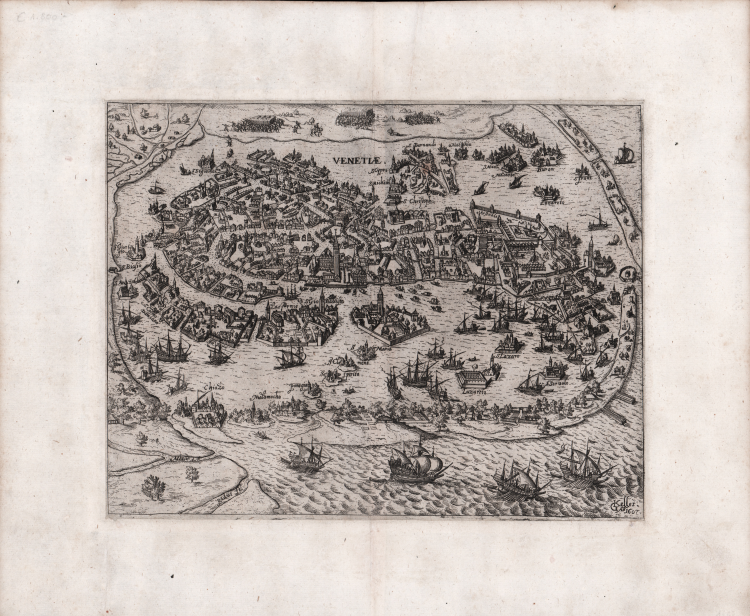



| Reference: | S39270 |
| Author | Georg KELLER |
| Year: | 1607 |
| Zone: | Venice |
| Printed: | Frankfurt |
| Measures: | 260 x 200 mm |


| Reference: | S39270 |
| Author | Georg KELLER |
| Year: | 1607 |
| Zone: | Venice |
| Printed: | Frankfurt |
| Measures: | 260 x 200 mm |
THE WAR OF THE INTERDICT
Rare perspective map of the city engraved by Georg Keller in 1607.
The plate is published in the Relationis Historicae Semestralis Continuatio... of 1607. The work, also better known as "Messerelationen" published in Frankfurt beginning in 1598, was printed at spring and autumn fairs to provide news of major international events whose author was Jacobus Francus, a pseudonym used by several writers, including Conrad Lautenbach and Conrad Memmius.
"Georg Keller of Frankfurt was one of the major interpreters of the change in graphic taste at the end of the 1500s, when illustration executed on copperplate took over from silography. His numerous views of cities go back without exception to earlier and often foreign models" (cf. Cassini, Piante e vedute prospettiche di Venezia, 1970, p. 69).
"The plan of the city with numerous place names refers to the perspective plans of the end of the sixteenth century taking up the iconographic motifs of the perspective plan of F. Hogenberg. The extension in the depiction of the mainland, which includes the mouth of the Adige and the Po to the south, is derived from the plan of C. Stimmer. G. Keller (1568-1634) was the author of numerous views of cities engraved in Berlin on copper plates" (cf. Romanelli-Biadene, Venezia, Piante e Vedute, 1982 p. 37, n. 24).
"In the upper part a military transfer is illustrated. In the lower part a showy parade of ships is on display" (cf. Moretto, Venetia, Le immagini della Repubblica, 2001, p. 114, plate 49).
As correctly stated by Moretto, compared to the traditional iconography of the city, the map presents the representation of military "elements". As mentioned, the plan is included in the "Messerelationen", and is therefore a so-called "occasion" map, created to describe a specific event. In this case the work is made to document the so-called war of the interdict (1606 - April 21, 1607).
It was a dispute between the Republic of Venice and the Papal State, which broke out in 1606 because of the arrest in Venice of two Catholic priests accused of common crimes and the adoption by the Serenissima of a series of laws aimed at the containment of ecclesiastical property. The pope Paul V (1605 - 1621) threatened to put an interdict on the city, that is to say to strike it with a sort of collective excommunication that would have placed Venice outside the Church, preventing any form of administration of the sacraments: the papal ultimatum was rejected and the Pope put into effect what he had threatened. Thanks to the mediation of France, however, a compromise was reached: Venice was freed from the interdict.
The sheet is published in the Relationis Historicae Semestralis Continuatio, Jacobi Franci Historische Beschreibung aller Denckwürdigen Geschichten, so sich hin und wider in Europa, Hoch- und Nider Teutschland, auch in Franckreich. The work, also known as "Messerelationen", published in Frankfurt since 1598, was printed on the occasion of spring and autumn fairs, to provide news about major international events. Early editions of the collection were signed in the name of Jacobus Francus, which was the pseudonym used by several writers, including Conrad Lautenbach and Conrad Memmius.
A Messrelation was a print published in the 16th to 18th century for the book fairs in Frankfurt and Leipzig (the largest in Europe at their time) which reported news about political and military news since the last fair. Messrelationen are seen as precursors to modern newspapers as they were the first printed news media to be published periodically.
The Austrian scholar Michael von Aitzing (ca. 1530–1598) is commonly seen as their inventor, having published for the first time a Relatio Historica (printed in Cologne) at the autumn 1583 book fair in Frankfurt, in which he related the events in the Low Countries since February 1580. This was a huge success and from 1588 Aitzing published his "relations" twice a year, for the Easter book fair at Leipzig and for the autumn book fair at Frankfurt. Since 1590, competitors published their own Messrelationen. The first one from Frankfurt was published in 1591 (running until 1806), the first one from Leipzig in 1605 (running until 1730).
Etching, signed and dated on the plate in the lower right corner, printed on contemporary laid paper, trimmed in copper and with coeval margins added, in perfect condition.
Literature
Cassini (1971): n. 32; Moretto (2001): n. 49; Romanelli-Biadene (1982): n. 44; Schulz (1970): p. 79, n. 43; Rosseaux, Ulrich (2004), Die Entstehung der Meßrelationen. Zur Entwicklung eines frühneuzeitlichen Nachrichtenmediums aus der Zeitgeschichtsschreibung des 16. Jahrhunderts, Historisches Jahrbuch, 124; Stöber, Rudolf (2000). Deutsche Pressegeschichte. Einführung, Systematik, Glossar. Constance. p. 51.
Georg KELLER (Francoforte 1568 - 1634)
|
German painter of historical subiects and engraver, also known as KG or GK Monogrammist.
|
Georg KELLER (Francoforte 1568 - 1634)
|
German painter of historical subiects and engraver, also known as KG or GK Monogrammist.
|